Transposable element abundance and fitness in maize
 In this interesting paper, Stritzer et al. asked a simple question, which required a very sophisticated approach to answer. Do transposable elements (TEs) affect fitness in maize? This is a particularly interesting question as 85% of the maize genome is composed of TEs or TE fragments, including over 350,000 TEs. Previous studies have shown a negative impact of TEs on fitness in yeast and Drosophila. A priori, transposons could affect fitness in several ways: through metabolic costs of their replication, through mutational effects caused by transposition, and through impacts on expression levels of nearby genes. The authors examined the US Nested Association Mapping (NAM) population, “a set of 4,975 genotyped recombinant inbred lines (RILs) generated from twenty-five parental inbred lines crossed to the original reference genotype of maize (B73) then self-pollinated for 4-6 generations”. Using grain yield as a proxy for fitness, they found a small negative effect of TE abundance. They further looked at TE position relative to nearby genes, TE age (determined by mutation accumulation from the consensus copy), and TE family. On aggregate, they found that for every additional 14 Mb of TE, fitness was decreased by 1 kernel per plant (about 0.1% of yield). However, younger TEs and TEs closer to genes have a more negative impact. This is an interesting paper with lots more to chew on, have a look. (Summary by Mary Williams @PlantTeaching) bioRxiv https://doi.org/10.1101/2023.09.18.557618
In this interesting paper, Stritzer et al. asked a simple question, which required a very sophisticated approach to answer. Do transposable elements (TEs) affect fitness in maize? This is a particularly interesting question as 85% of the maize genome is composed of TEs or TE fragments, including over 350,000 TEs. Previous studies have shown a negative impact of TEs on fitness in yeast and Drosophila. A priori, transposons could affect fitness in several ways: through metabolic costs of their replication, through mutational effects caused by transposition, and through impacts on expression levels of nearby genes. The authors examined the US Nested Association Mapping (NAM) population, “a set of 4,975 genotyped recombinant inbred lines (RILs) generated from twenty-five parental inbred lines crossed to the original reference genotype of maize (B73) then self-pollinated for 4-6 generations”. Using grain yield as a proxy for fitness, they found a small negative effect of TE abundance. They further looked at TE position relative to nearby genes, TE age (determined by mutation accumulation from the consensus copy), and TE family. On aggregate, they found that for every additional 14 Mb of TE, fitness was decreased by 1 kernel per plant (about 0.1% of yield). However, younger TEs and TEs closer to genes have a more negative impact. This is an interesting paper with lots more to chew on, have a look. (Summary by Mary Williams @PlantTeaching) bioRxiv https://doi.org/10.1101/2023.09.18.557618







